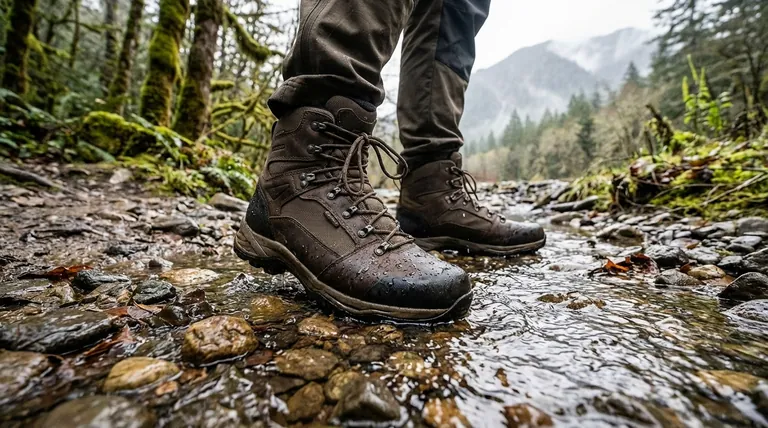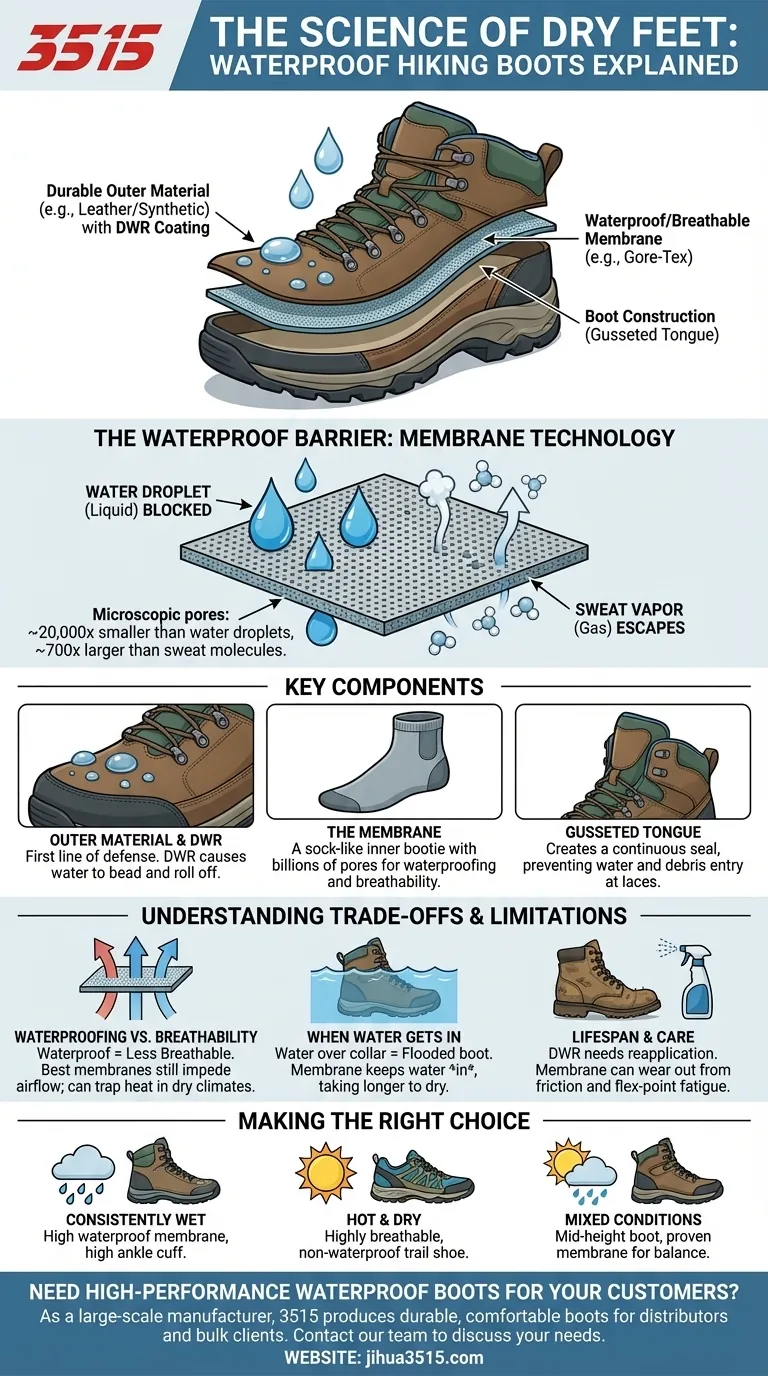Ultimately, waterproof hiking boots keep feet dry by using a multi-layered system, the core of which is a waterproof, breathable membrane. This high-tech layer is combined with a durable outer material and a specific boot construction to create a barrier that blocks external water while allowing internal sweat vapor to escape.
The essential technology is a microscopic barrier—a membrane—with pores large enough to let small water vapor (sweat) molecules out, but too small for larger liquid water droplets to get in. This prevents your feet from getting soaked by rain and puddles, while also stopping them from getting soaked by their own sweat.

Deconstructing the Waterproof Barrier
A truly waterproof boot is more than just a coating; it's an integrated system of materials and construction designed to work together. Understanding these components helps you see why some boots perform better than others.
The Waterproof/Breathable Membrane
This is the most critical component. Most modern waterproof boots contain a full, sock-like inner bootie made from a membrane material like Gore-Tex or a similar proprietary technology.
This membrane is a sheet of material perforated with billions of microscopic pores per square inch. These pores are the key to its function: they are about 20,000 times smaller than a water droplet but 700 times larger than a molecule of water vapor.
This design creates a one-way street for water. Rain, puddle splashes, and mud are physically blocked from entering, while the heat and moisture from your sweat can pass through and escape from the boot.
The Role of the Outer Material
The boot's exterior—typically made of leather, suede, or synthetic fabrics—serves as the first line of defense. It provides the structure and durability needed to protect your feet from rocks, roots, and thorns.
This outer layer is almost always treated with a Durable Water Repellent (DWR) finish. This chemical coating causes water to bead up and roll off the surface, preventing the outer material from becoming saturated, which would compromise breathability and make the boot feel heavy.
Key Construction Features
Beyond the materials, the physical construction is vital. A gusseted tongue, which is a tongue that is attached to the boot's upper along the sides, is a crucial feature.
This design creates a continuous barrier that prevents water, dirt, and debris from entering the boot through the vulnerable area around the laces. Without it, a shallow puddle could easily flood the boot.
Understanding the Trade-offs
No technology is perfect. While waterproof boots are essential for many conditions, it's important to understand their inherent limitations to choose the right footwear for your environment.
Waterproofing vs. Breathability
There is always a trade-off between how waterproof a boot is and how breathable it is. Even the best membrane impedes airflow to some degree.
A highly waterproof boot will be less breathable than a non-waterproof, mesh-heavy trail runner. In hot and dry climates, a waterproof boot can trap heat and sweat, leading to more discomfort and blisters than a more ventilated option.
When Water Gets In
The biggest weakness of a waterproof boot is when water gets over the top. If you step in a stream that is deeper than the boot's collar, water will pour inside.
Because the waterproof membrane is designed to keep water out, it also does an excellent job of keeping it in. A flooded waterproof boot will take significantly longer to dry out on the trail than a non-waterproof one.
The Lifespan of "Waterproof"
The waterproof system is not invincible. Over time, the DWR coating on the exterior will wear off and need to be reapplied with a spray or wash-in treatment.
Furthermore, the internal membrane can be damaged by grit and friction or develop flex-point fatigue after hundreds of miles, compromising its ability to block water.
Making the Right Choice for Your Hikes
Choosing the right boot means matching the technology to the terrain and climate you'll be facing.
- If your primary focus is hiking in consistently wet, rainy, or muddy conditions: A boot with a high-quality waterproof/breathable membrane and a high ankle cuff is your most reliable choice.
- If your primary focus is hiking in hot, dry climates with only rare water exposure: A non-waterproof but highly breathable trail shoe may serve you better by maximizing sweat evaporation.
- If your primary focus is all-purpose hiking in mixed conditions: A mid-height boot with a proven membrane offers a great balance of protection, support, and weather resistance.
Understanding how these systems work empowers you to select the right tool for your feet, ensuring comfort and protection on any trail.
Summary Table:
| Component | Function | Key Features |
|---|---|---|
| Waterproof Membrane | Blocks liquid water, allows sweat vapor to escape | Microscopic pores (e.g., Gore-Tex), sock-like bootie |
| Outer Material | First line of defense, provides structure | Leather or synthetics with DWR coating |
| Boot Construction | Creates a continuous barrier | Gusseted tongue to seal out water at the laces |
Need high-performance waterproof boots for your customers?
As a large-scale manufacturer, 3515 produces a comprehensive range of durable and comfortable waterproof hiking boots for distributors, brand owners, and bulk clients. Our production capabilities ensure top-tier quality and reliable delivery.
Contact our team today to discuss your specific needs and get a quote.
Visual Guide

Related Products
- High Performance Fire-Retardant Waterproof Safety Boots
- Safety Footwear Wholesale Manufacturer for Custom OEM/ODM Production
- Factory Direct Wholesale Rain Boots Durable Waterproof & Fully Customizable
- Premium Flame-Retardant Waterproof Safety Boots and Shoes
- Wholesale Premium Waterproof Nubuck Safety Shoes Boots
People Also Ask
- What are the main types of safety-toe boots? Choose the Right Protection for Your Job
- What factors should be considered when choosing between steel and composite toe caps? Ensure Maximum Safety and Comfort
- How can comfort be improved when wearing steel toe boots? A Guide to Pain-Free Workdays
- Why choose steel toe boots over composite? For Maximum Impact Protection & Durability
- How does the weight of steel-toe boots compare to composite-toe boots? Uncover the Real Trade-Offs



















